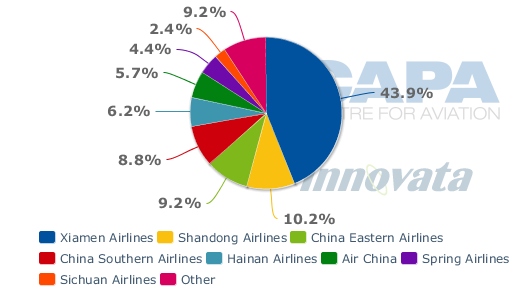Xiamen Airlines gears up for international expansion
Xiamen Airlines, China's sixth largest carrier and the world's 27th largest by available seat kilometres, is gearing up for more forays into the international market. Xiamen is predominately a domestic carrier with only 5.7% of available seats allocated to international services. Xiamen in May-2011 ordered six Boeing 787s for services to Europe and North America after their 2014/15 delivery dates. But international expansion, albeit medium-haul and not long-haul, can commence earlier with the carrier retrofitting its 757s with a three-class configuration, including having lie-flat beds in first class.
- Xiamen Airlines, China's sixth largest carrier, is planning to expand its international market presence.
- The airline has ordered six Boeing 787s for future services to Europe and North America.
- Xiamen Airlines is retrofitting its 757s with a three-class configuration, including lie-flat beds in first class, to facilitate medium-haul international expansion.
- Xiamen Airlines currently has a small proportion of international capacity compared to its domestic capacity.
- The expansion into international markets is driven by the competition from China's high-speed rail network, which is impacting domestic air travel.
- Xiamen Airlines aims to improve its product and become the 20th largest carrier by 2015, with plans to carry 30 million passengers annually.
Xiamen's fleet of six 757-200s operate in a two-class configuration primarily on domestic trunk routes (such as to Beijing) but are being retrofitted to a three-class configuration, including lie-flat beds in first class. Such a premium configuration for the domestic market is uncommon in China. Only two of the 757s have so far been retrofitted, and while Xiamen has not announced its strategy for the retrofitted aircraft, which are the largest in its fleet and have the longest range, they could be used to open international services before the 787 arrives. The fleet would largely be confined to regional Asia and not facilitate opening its planned routes to Europe or North America, or even possibly Australia.
Amongst its peers, Xiamen Airlines has the second-least proportion of international capacity, just ahead of Sichuan Airlines. Sichuan plans to this year deploy A330s to Europe, North America and possibly Australia.
See related article: Sichuan Airlines expanding network from Chengdu with Australia, Europe & North America routes
Domestic vs international capacity for China's six largest carriers based on available seat kilometres: 05-Mar-2012 to 11-Mar-2012
| Air China | China Eastern | China Southern | Hainan Airlines | Sichuan Airlines | Xiamen Airlines | |
|---|---|---|---|---|---|---|
| Total ASK ranking for China | 1 | 3 | 2 | 5 | 4 | 6 |
| International ASKs as percent of total | 41.3% | 33.3% | 24.3% | 14.4% | 5.7% | 6.8% |
| Domestic ASKs as percent of total | 58.% | 66.7% | 75.7% | 85.6% | 94.3% | 93.2% |
Common impetus for international expansion: high-speed rail competition
Xiamen Airlines has reported 24 consecutive years of profits, but like other carriers, is increasingly turning to international markets. The opportunities - higher margins and prestige for the airline and country - are accompanied by a necessity: the previously core domestic Chinese air travel market is being eaten away by China's rapidly expanding high-speed rail network.
See related article from CAPA's strategy journal Airline Leader: China's airlines likely to turn to international markets as high-speed rail networks roll out
China Southern is the most affected by high-speed rail, with the carrier expecting high-speed rail to eventually replace a quarter of its network; the carrier is also the most aggressive internationally, with severe implications for other carriers.
See related article: Chinese airlines' sixth freedom roles could challenge Middle East, Asian, European hubs this decade
Xiamen Airlines, however, does not come off lightly. At the carrier's home base of Xiamen Airport, where it accounts for 43.9% of all domestic capacity, one-third of all domestic services risk being threatened by high-speed rail over the next few years.
Xiamen Airport capacity by carrier (seats per week): 05-Mar-2012 to 11-Mar-2012
Product improvement as Chinese carriers seek global aspirations
The introduction into Xiamen's 757s of lie-flat beds, a relatively new occurrence in mainland China, also reflects how Chinese carriers are improving their product. The causes are multiple. While growth in China will be large, competition will increase; service and product can be a point of differentiation. Targeting international markets and their passengers requires a more internationally competitive product.
Xiamen's rise - it wants to be the 20th largest carrier by the end of the 12th Five Year plan, ending in 2015 - is being accompanied by membership in the SkyTeam alliance as well as fleet growth from the current 78 to 136 by 2015. (Xiamen only has 36 aircraft on order, suggesting an order in the short-term is likely.) With its fleet, Xiamen hopes to carry 30 million passengers annually by 2015, up from a 16.4 million in 2011. Also remaining to play out is how Xiamen will complement the international expansion of 60% owner China Southern Airlines.
See related articles:
